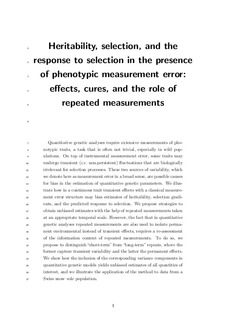| dc.contributor.author | Ponzi, Erica | |
| dc.contributor.author | Keller, Lukas F. | |
| dc.contributor.author | Bonnet, Timothee | |
| dc.contributor.author | Muff, Stefanie | |
| dc.date.accessioned | 2019-12-16T14:55:10Z | |
| dc.date.available | 2019-12-16T14:55:10Z | |
| dc.date.created | 2019-11-26T13:35:59Z | |
| dc.date.issued | 2018 | |
| dc.identifier.citation | Evolution. 2018, 72 1992-2004. | nb_NO |
| dc.identifier.issn | 0014-3820 | |
| dc.identifier.uri | http://hdl.handle.net/11250/2633474 | |
| dc.description.abstract | Quantitative genetic analyses require extensive measurements of phenotypic traits, a task that is often not trivial, especially in wild populations. On top of instrumental measurement error, some traits may undergo transient (i.e., nonpersistent) fluctuations that are biologically irrelevant for selection processes. These two sources of variability, which we denote here as measurement error in a broad sense, are possible causes for bias in the estimation of quantitative genetic parameters. We illustrate how in a continuous trait transient effects with a classical measurement error structure may bias estimates of heritability, selection gradients, and the predicted response to selection. We propose strategies to obtain unbiased estimates with the help of repeated measurements taken at an appropriate temporal scale. However, the fact that in quantitative genetic analyses repeated measurements are also used to isolate permanent environmental instead of transient effects requires that the information content of repeated measurements is carefully assessed. To this end, we propose to distinguish “short‐term” from “long‐term” repeats, where the former capture transient variability and the latter help isolate permanent effects. We show how the inclusion of the corresponding variance components in quantitative genetic models yields unbiased estimates of all quantities of interest, and we illustrate the application of the method to data from a Swiss snow vole population. | nb_NO |
| dc.language.iso | eng | nb_NO |
| dc.publisher | Wiley | nb_NO |
| dc.title | Heritability, selection, and the response to selection in the presence of phenotypic measurement error: effects, cures, and the role of repeated measurements. | nb_NO |
| dc.type | Journal article | nb_NO |
| dc.type | Peer reviewed | nb_NO |
| dc.description.version | acceptedVersion | nb_NO |
| dc.source.pagenumber | 1992-2004 | nb_NO |
| dc.source.volume | 72 | nb_NO |
| dc.source.journal | Evolution | nb_NO |
| dc.identifier.doi | 10.1111/evo.13573 | |
| dc.identifier.cristin | 1752478 | |
| dc.description.localcode | This is the peer reviewed version of an article, which has been published in final form at [https://doi.org/10.1111/evo.13573]. This article may be used for non-commercial purposes in accordance with Wiley Terms and Conditions for Self-Archiving. | nb_NO |
| cristin.unitcode | 194,63,15,0 | |
| cristin.unitname | Institutt for matematiske fag | |
| cristin.ispublished | true | |
| cristin.fulltext | original | |
| cristin.qualitycode | 2 | |
